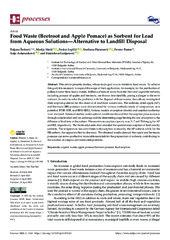Prikaz osnovnih podataka o dokumentu
Food waste (beetroot and apple pomace) as sorbent for lead from aqueous solutions – alternative to landfill disposal
| dc.creator | Šoštarić, Tatjana | |
| dc.creator | Simić, Marija | |
| dc.creator | Lopičić, Zorica | |
| dc.creator | Zlatanović, Snežana | |
| dc.creator | Pastor, Ferenc | |
| dc.creator | Antanasković, Anja | |
| dc.creator | Gorjanović, Stanislava | |
| dc.date.accessioned | 2023-10-12T10:41:11Z | |
| dc.date.available | 2023-10-12T10:41:11Z | |
| dc.date.issued | 2023 | |
| dc.identifier.issn | 2227-9717 | |
| dc.identifier.uri | https://ritnms.itnms.ac.rs/handle/123456789/877 | |
| dc.description.abstract | This article presents studies, whose main goal was to minimize food waste. To achieve this goal, it is necessary to expand the scope of their application, for example, for the purification of polluted water from heavy metals. Millions of tons of waste from the fruit and vegetable industry, including pomace of apples and beetroots, are thrown into landfills, posing a danger to the environment. In order to solve the problems with the disposal of these wastes, the authors investigated their sorption potential for the removal of lead from wastewater. The sorbents, dried apple (AP), and beetroots (BR) pomaces were characterized by various methods (study of composition, zeta potential, FTIR-ATR, and SEM-EDX). Various models of sorption kinetics and sorption isotherms were analyzed. Kinetical studies under optimal conditions showed that the sorption process occurs through complexation and ion exchange and the determining stage limiting the rate of sorption is the diffusion of lead ions in the sorbent. The maximum sorption capacity was 31.7 and 79.8 mg/g for AP and BR, respectively. The thermodynamic data revealed the spontaneous sorption of lead ions by sorbents. The temperature rise contributes to the sorption increase by the AP sorbent, while for the BR sorbent, the opposite effect is observed. The obtained results showed that apple and beetroots pomaces can serve as effective renewable materials for the preparation of sorbents, contributing to the solution of complex environmental problems. | sr |
| dc.language.iso | en | sr |
| dc.publisher | MDPI | sr |
| dc.relation | info:eu-repo/grantAgreement/MESTD/inst-2020/200023/RS// | sr |
| dc.relation | info:eu-repo/grantAgreement/MESTD/inst-2020/200051/RS// | sr |
| dc.relation | info:eu-repo/grantAgreement/MESTD/inst-2020/200168/RS// | sr |
| dc.rights | openAccess | sr |
| dc.rights.uri | https://creativecommons.org/licenses/by/4.0/ | |
| dc.source | Processes | sr |
| dc.subject | organic waste | sr |
| dc.subject | apple pomace | sr |
| dc.subject | beetroot pomace | sr |
| dc.subject | lead sorption | sr |
| dc.title | Food waste (beetroot and apple pomace) as sorbent for lead from aqueous solutions – alternative to landfill disposal | sr |
| dc.type | article | sr |
| dc.rights.license | BY | sr |
| dc.citation.issue | 5 | |
| dc.citation.volume | 11 | |
| dc.identifier.doi | 10.3390/pr11051343 | |
| dc.identifier.fulltext | http://ritnms.itnms.ac.rs/bitstream/id/1380/processes-11-01343-v2-1.pdf | |
| dc.type.version | publishedVersion | sr |

